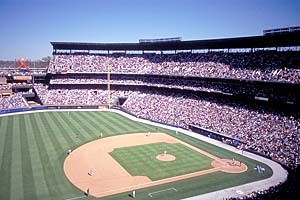Turner Field
In 1990, The Olympic Games announced that Atlanta would be host to the 100th anniversary of the Olympics. The city of Atlanta used this to kill two birds with one stone: build a memorable state-of-the-art Olympic venue as well as to replace the outdated Atlanta-Fulton County Stadium. The city of Atlanta built Centennial Olympic Stadium in the parking lot just south of Atlanta-Fulton County Stadium. It was a track and field stadium that would eventually be reconstructed into a baseball field once the games were over. In Robert Emory Lee Bailey’s thesis titled “If You Build It: Implementing Principles of Transit Oriented Development Within the Turner Field Neighborhoods”, he claimed that the building of Centennial Olympic Stadium was “an incentive to accomplish long-sought development goals” (Bailey 72). The long-sought development goals that he notes were the goals for the Braves and Falcons to have new stadiums.
Centennial Olympic Stadium was also home to a few legendary moments. On that field Muhammad Ali mustered up the strength to light the Olympic cauldron and Michael Johnson set a world record for the 200m track and field race, finishing the race in 19.66 seconds. After the games were over, the 85,000 capacity track and field stadium was transformed into a baseball stadium with the capacity of 50,000. Named after the Braves’ owner Ted Turner, Turner field was the new home of the Atlanta Braves. Turner Field was home to the Atlanta Braves for 19 years. Turner Field saw many greats pass through it. The legendary pitching trio of John Smoltz, Greg Maddux, and Tom Glavine terrified batters at this park. Chipper Jones was the face of the Atlanta Braves during their Turner Field tenure.
